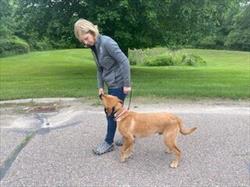Melissa Spooner-Raymond, LVT, VTS (Behavior), BS, KPA-CTP, TAGteach Level One
Taking your dog for a walk should be an enjoyable event; walks are the primary reason some people get a dog. For some owners, issues arise that make going on walks less enjoyable. Let’s think about some options to help you both enjoy your walks more.
Walking Your Dog

Photo courtesy of Melissa Spooner-Raymond, LVT, VTS (Behavior), BS, KPA-CTP, TAGteach Level One
The Purpose of the Walk
Before heading out with your four-legged best friend in tow, know the purpose of your walk. Is exercise your primary reason? Who needs the exercise, you, your dog, or both? Walking improves your cardiovascular health, builds stronger muscles, and lowers your blood pressure and stress levels. However, if it takes you 60 minutes to walk a half mile because your dog insists on eliminating at every mailbox or light post then your heart rate might never make it to the necessary levels for cardiovascular benefit. A simple solution is to walk in an area with fewer distractions. Avoid public parks, neighborhoods, and subdivisions that have many tempting distractions. Instead, choose an open field, a state park, or a beach.
If your health is not the primary goal, then what is? Is your dog the one in need of exercise? Are you trying to improve their physique, or do you have another goal in mind? Often we look to walking as a solution for weight management or to burn off energy. If you have a busy dog that never runs out of energy, then taking them for regular walks seems like the best solution. As with humans, walking has many health benefits for dogs including building muscle and becoming stronger. However, over a period of time, you may notice a walk that previously tired them out no longer has the same effect. While walks are helpful for a dog that needs to shed some weight, they may not be ideal if your goal is to burn off energy. As their stamina increases, more intense walks may be needed to truly exhaust them. A solution to this issue may be to modify the type of walk you take.
Walks as Enrichment
Did you know that about 15 minutes of mental work for a dog is the equivalent of taking your dog on a 1-mile walk? Have you ever worked on a project intensely all day long and after you were done you felt like you ran a marathon? That is because your brain did all the heavy lifting. Mental exercise and brain games are often referred to as enrichment. Enrichment is not only enjoyable but also tiring! You can offer it to dogs in many different forms. Sniff walks are one of the many methods. This form of enrichment puts the responsibility of deciding where to go and how long to stay completely on the dog. If your dog wants to spend 15 minutes sniffing one single spot, let them. As long as it is safe, allow them to have all the power. This may include following behind on the other end of the leash while your dog keeps their ears forward and their nose to the ground, as they track a particular scent. In order to help your dog understand the difference between a regular walk, where you want them to maintain good manners, and a sniff walk, put the various behaviors on a cue. Changing to a different leash for sniff time during your walk is one way of cueing your dog to start the behavior. Another may be to signal that it is okay to start by using a verbal cue such as “go sniff” and pointing to an area for them to go to.
Another easily implemented form of enrichment is varying your path. It is easy to get stuck in a pattern of walking the same path time after time. Your dog knows exactly where and when to turn and may even show signs of reluctance once they know they are heading home. Even small variations on your walk will make it a more enriching experience for your dog.
Training as Enrichment on Walks
Training is another way to include enrichment in your walk. Positive reinforcement (reward based) training by itself can be an enjoyable way to interact with your dog. Up the ante and take your training on the go. Request your dog to follow known cues at different periods of your walk. Consider playing a game. You can plan the details of this game in advance or decide when you’re on the walk.
- Ask your dog to “down” every time you see another dog.
- When a car passes ask for a “high five.”
- While hearing a funny noise cue “touch.”
- Before crossing a street or intersection, ask for a 15-second sit.
The behaviors you choose should be easy for your dog to offer and most of all fun! This exercise is all about tapping into your dog’s brain and making them think in varying environments with natural distractions. Keep it lighthearted. There should be no penalty for incorrect or undesirable behaviors. If your dog struggles, consider making it easier for them to get it right and keep moving forward.
Choosing any one of these enrichment techniques are sure to successfully meet your dog’s mental needs and give you a reprieve from some of their unwanted hyperactivity.